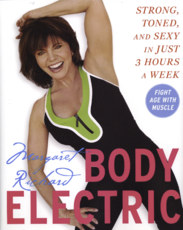 Excerpt
from Body Electric
Excerpt
from Body Electric
by Maragret Richard
Flexibility and Stretching
Maybe, just maybe, if we stretched more, we would be less uptight, and peace would reign throughout the land. That may be wishful thinking, but at the very least we would be able to tie our sneakers when we're ninety! Flexibility, or the lack thereof, is probably the single most important factor affecting our quality of life as we age. The pain and stiffness of aging begin as temporary tensions that become learned habits. But don't assume that with aging you will automatically lose your flexibility. You can counterbalance the effects of aging so that your physiology is quite a bit younger than your chronology. When you stay flexible, you'll be able to live with vibrancy, energy, and independence.
The Benefits of Stretching
Over the years, we develop habitual ways of using our muscles to move and position ourselves. Poor posture and a lack of flexibility may be the result of a legitimate medical problem or may be the result of limited stretching and improper body alignment. When muscles get tight and stay tight, they cease to be elastic and they restrict movement. That sense of restriction, or stiffness, often leads to disuse. Disuse causes weakness and tightness, which in turn causes a vicious cycle of more disuse, weakness, and tightness. You have to “lube your chassis” to ensure a smooth ride. Regular stretching activates fluids in your joints, thereby reducing the wear-and-tear caused by friction. Increased water intake is also believed to contribute to increased mobility for tissues and joints that have become less supple.
Your muscles may also become tight and short due to overuse (resulting in injuries such as tennis elbow or tendonitis) or underuse. If nothing is done to lengthen stiff and short muscles, they continue to tighten, restricting circulation and impeding the removal of toxins. And a short and tight muscle is more prone to injury. Ouch!
It is easy to take your physical capabilities for granted, until there is a problem. Your long-term goal should be to maintain your range of motion so that you can continue to accomplish everyday tasks, pain-free. This goal is totally realistic if you are willing to commit to a regular schedule of careful stretching. The benefits of a stretching program will be readily apparent, and you will experience increased comfort as your body moves with fluidity and balance.
Stretching is the best way to maintain muscle and joint flexibility. When you stretch regularly, you will also reduce general muscle tension. A prime benefit of stretching is that it increases the distance your limbs can travel before injury occurs to the muscles and tendons.
Runners, in particular, suffer from painful hamstring injuries. These sprains and strains -- even tears -- of the muscle fibers are most likely the result of tight, inflexible hamstring muscles creating an imbalance with the opposing quadriceps. Every muscle in your body has an opposing muscle. It stands to reason that your muscles will experience less fatigue when a contracting muscle does not have to exert as much force against a flexible opposing muscle.
Here are some tips for stretching efficiently:
- The best time to stretch is following your workout, when your muscles are warm. Stretching, as part of an effective cooldown, helps to alleviate
the soreness of post-workout
muscles caused by microscopic muscle tears and accumulated waste
products (lactic acid). Stretching lengthens the individual muscle
fibers, thereby increasing blood circulation, which helps to remove the
waste products, and reducing muscle soreness. A warm bath or shower
will also suffice to warm you up, if you prefer.
- Stretch your muscles back to
their resting length after each exercise. Exercising your
muscles with resistance, as we do in this program, results in stronger
-- and temporarily shorter -- muscles. Shortened muscle fibers are more
easily injured. Be sure to perform the muscle-specific stretches I
offer following each exercise.
- Stretch every third day for five
to ten minutes to keep your muscles supple. If your muscles are
particularly tight, you may want to perform gentle stretching more
often.
- Static stretching gradually
lengthens a resting muscle. As the word static implies, there is no
bouncing or reaching once you have stretched your muscle to an
elongated position. Hold the stretch for fifteen to thirty seconds. As
always, focus on correct body alignment. Once a
muscle has reached its absolute maximum length, attempting to stretch
it further may cause undue stress to your ligaments and
tendons. As always, focus on correct body alignment.
Copyright © 2008 Margaret Richard
